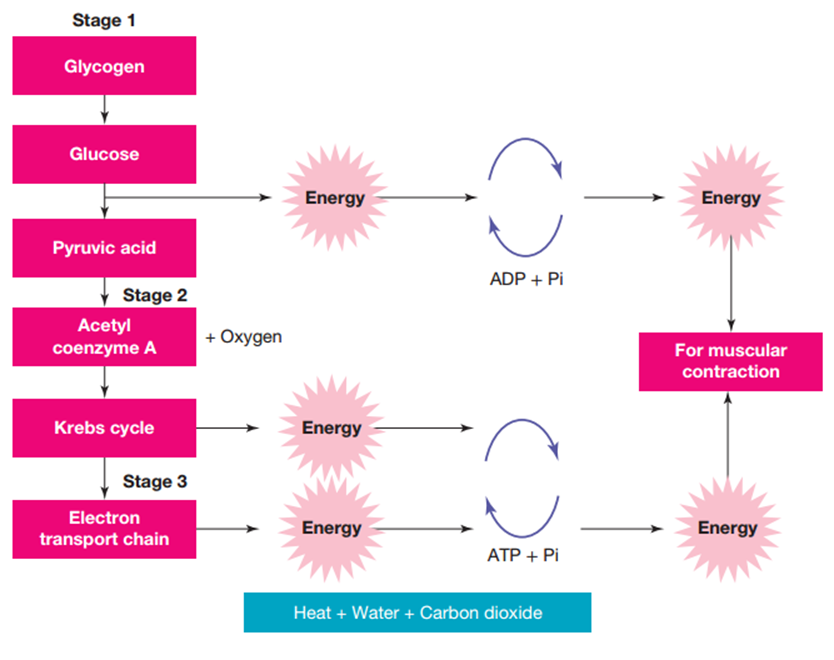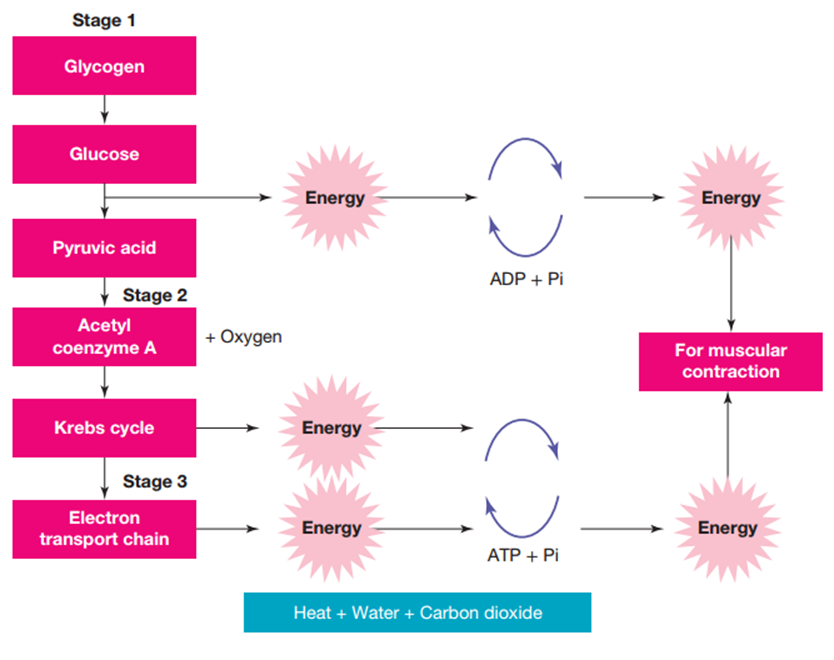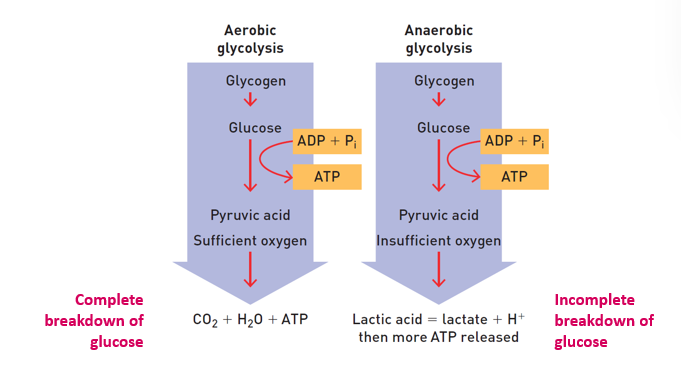6.7 - aerobic energy system
1/31
There's no tags or description
Looks like no tags are added yet.
Name | Mastery | Learn | Test | Matching | Spaced |
|---|
No study sessions yet.
32 Terms
What is the primary energy system used during submaximal physical activity
The aerobic energy system
Why is the aerobic system preferred during submaximal activity
Because there is enough time to use oxygen to produce ATP
What is the main disadvantage of the aerobic energy system
It is the slowest energy system due to complex chemical reactions
What is the main advantage of the aerobic energy system
It produces the greatest yield of ATP
What fuels can the aerobic energy system use
carbohydrates (glycogen)
fats (triglycerides, FFAs)
under extreme conditions, proteins
What fuel does the aerobic system prefer at rest
Free fatty acids (FFAs)
What fuel does the aerobic system prefer during submaximal to maximal intensity
1st: Carbohydrates (CHO)
2nd: Triglycerides
3rd: Protein
What is the rate and yield of ATP for the aerobic system
Slow to slowest rate, due to complex chemical reactions and oxygen delays, fats slower than CHO
large to largest yield (38 ATP from glucose, 441 ATP from triglycerides)
What is the duration and intensity range of the aerobic system
Duration: Long (over 120 seconds in continuous examples).
Intensity: Low to submaximal (<80% max HR).
resting or submaximal intensity
What are the by-products of the aerobic energy system
Carbon dioxide (CO₂)
water (H₂O)
heat
What is an example activity relying on the aerobic system
Marathon
basketball game
what does aerobic depend on
oxygen being transported to working muscles
Why does the aerobic system prefer carbohydrates over fats
Carbs:
Can be metabolised aerobically or anaerobically
Produce energy faster than fats
Require less oxygen to completely oxidise than fats
Are more accessible than fats
(this is true because triglycerides have to be reduced to glycerol and free fatty acids before they can be used to generate cellular energy)
Why are fats used more during low-intensity aerobic activities
Because oxygen is more readily available, and fats can be broken down slowly over time
What limits the aerobic system
Which all end up…
Fuel depletion
elevated core temperatures
dehydration
reduced CNS firing
all end up reducing muscular contraction and therefore intensity over time
What are the three processes of aerobic metabolism of carbohydrates
Aerobic glycolysis → Krebs cycle → Electron transport chain
What happens to pyruvic acid in aerobic conditions
It is converted into acetyl coenzyme A

what happens in the Krebs cycle
Acetyl coenzyme A is oxidised, producing hydrogen ions

What happens in the electron transport chain
Hydrogen ions combine with oxygen to form ATP, CO₂, and H₂O

Aerobic system vs anaerobic system diagram of process comparison

When is the aerobic system primarily used
At rest and during low- to moderate-intensity exercise, including recovery
What fuel does the body primarily use at rest
Fats (about 2/3 of ATP is supplied aerobically from fats due to abundant oxygen availability)
Why is fat the preferred fuel source at rest
Because there is an abundant supply of oxygen, and the body has time to use the slower aerobic lipolysis system (don’t refer to this system in answers)
What fuel does the body prefer during low- to moderate-intensity exercise (especially steady-state)
Carbohydrates (CHO)
Why does the body shift to carbohydrates as exercise intensity increases
They can be metabolised aerobically and anaerobically
They produce energy faster than fats
They require less oxygen to oxidise completely
They are more readily accessible than fats
Why are carbohydrates more readily accessible than fats
Because triglycerides must first be broken down into glycerol and free fatty acids before being used, while carbohydrate stores are easier to access
How does intensity affect fuel use in aerobic conditions
As intensity increases, the body shifts from fats to carbohydrates for faster energy production
What is an active recovery
Low-intensity activity (50–60% MHR) for 5–10 minutes after exercise, using the same muscles
Why can H⁺ ions accumulate during endurance events, even though the aerobic system is the main ATP supplier
During high-intensity bursts, the athlete exceeds aerobic capacity and relies more on anaerobic glycolysis, which produces H⁺ ions as by-products.
These can accumulate and contribute to fatigue
What are the benefits of active recovery (summary)
Oxidises H+ ions and other by-products
Maintains elevated heart rate and blood flow
Uses the muscle pump to enhance venous return
Aids thermoregulation
Reduces venous pooling
What are the benefits of active recovery (depth)
accelerates the oxidation of metabolic by-products such as H+ ions that have accumulated in the muscle
maintains an elevated heart rate to increase blood flow to the working muscles
provides a skeletal muscle pump to increase blood flow back to the heart
assists with thermoregulation by slowly reducing core temperature
decreases venous pooling, where blood tends to remain or “pool” around muscles for longer periods during passive recovery because the muscles are not promoting blood flow returning to the heart.
Why might aerobic recovery also require thermoregulation or nutrition
Because environmental conditions and exercise duration can affect recovery needs